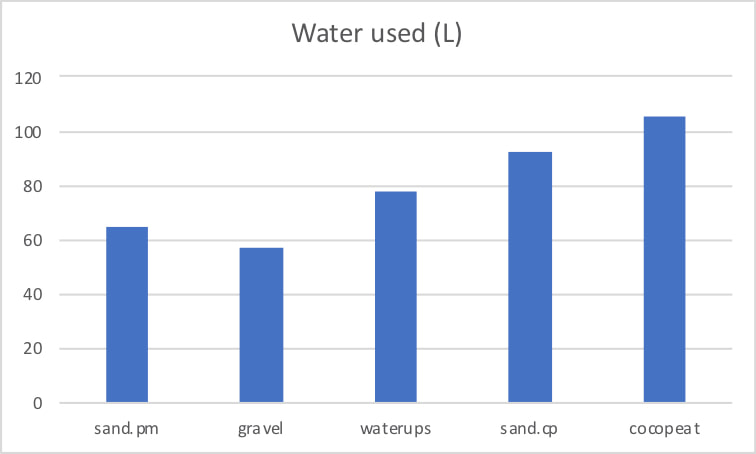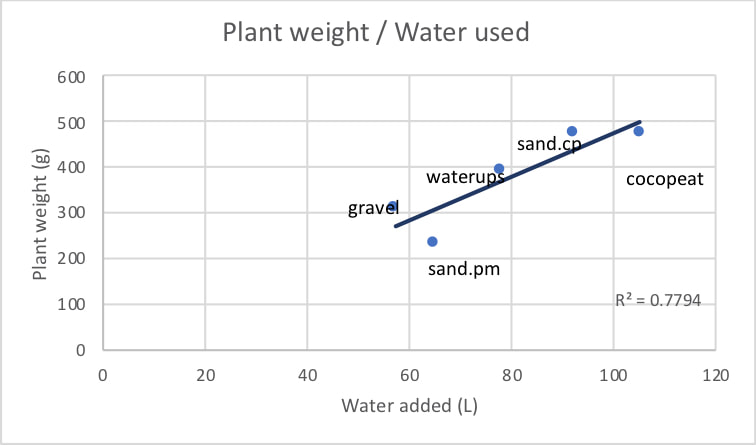|
The preliminary results from my first wicking bed experiment are in. I have more analysis to do to understand the significance of these results and I have another experiment under way that will provide more data. So I don't regard this as the final answer as to what's the best way to construct a wicking bed but it does provide some insights. This experiment tested four reservoir media: washed sand, 10mm gravel, WaterUps, and a mix of cocopeat, compost and sand. Two growing media were used
The Potting Mix was only used with a sand-filled reservoir. The Cocopeat Mix was used with all four reservoir materials. Three replicates of each combination were used. Spinach seedlings were planted on 17/10/19 and plants were harvested and weighed on 17/1/20. The water reservoirs were full at time of planting, topped up as needed through the experiment and refilled after harvest. The total amount of water added to each bed was recorded. The average plant weight per bed is shown in the following graph. The best growth was from the bed completely filled with Cocopeat Mix. The beds with a sand reservoir and Cocopeat Mix growing medium (labelled sand.cp) grew slightly less. The beds with the Potting Mix (sand.pm) grew the least. A wicking bed with a gravel reservoir and Cocopeat Mix growing medium was the worst performing of the beds for plant growth. The amount of water used was pretty much in line with the amount of growth, except for the Potting Mix wicking beds. The following graphs show the average amount of water used per bed and the correlation between the plant weight and the water used. Based on these results, the simple design using the Cocopeat Mix for both the reservoir and growing layers is best.
I have some concerns about the long-term performance of this design since I have found in other wicking beds that I have built that potting mix/compost in the reservoir decomposes anaerobically and deteriorates into a black sludge. I have had better long-term results using a 50:50 mix of garden soil and compost through the whole wicking bed but I haven't done a controlled experiment to test this yet. Washed sand in the reservoir layer appears to be a good choice and sand would not suffer from decomposition. I am not drawing any conclusions on the WaterUps product from this experiment. I filled the hollow legs of the WaterUps with coarse perlite and have subsequently found that this does not wick as well as perlite with smaller particles. In my next experiment I have replaced the perlite in the WaterUps with the cocopeat mix that I know does wick well. As I hypothesised before the start of this experiment, 10mm gravel did not perform well as a reservoir material. Gravel does not have good wicking properties and even though the reservoir was 200mm deep, only part of the water was able to wick up into the growing medium. I currently have the same wicking beds planted with lettuce and am recording more detailed measurements of soil moisture at various depths that should allow me to draw more certain conclusions about the better materials for wicking beds. I'll report on those results in the future. At the moment the lettuce growth is spectacular.
15 Comments
Kate Laffer
26/9/2020 12:35:29 pm
What about crusher dust as the reservoir medium? Your earlier tests showed it had the best wicking ability. Any reason for not including it in your vege growing tests?
Reply
Chris Curtis
26/9/2020 12:59:34 pm
Hi Kate,
Reply
Darby Bicheno
6/10/2020 12:10:27 pm
Hi there, Thank you so much for performing and publishing this information. I'm in the process of building my wicking beds, and it's great to see some definitive numbers on what media to use in the reservoir.
Reply
Chris Curtis
6/10/2020 12:32:30 pm
Hi Darby, Thanks for your comments. With sand in the reservoir I think there is a big advantage to also having something in there that makes empty spaces that fill with water - eg. ag pipe, upturned pots. Perhaps cover then with geotextile so they don't fill with sand, but it is important to have some areas of sand that go down between the spacers to the bottom of the wicking bed. This gives you more water storage in the reservoir but I have some evidence that it also improves the wicking (more experiments are about to start to prove this). Garden soil and compost should be fine. That's what I have used for years. I only used cocopeat in these experiments because I wanted something standardised and repeatable - there is soo much variation in soils. I'm doing the final edits on my honours thesis now so I should be publishing more results soon. Cheers! Chris
Reply
Darby Bicheno
6/10/2020 01:14:57 pm
Hey thanks for the reply!
Chris Curtis
6/10/2020 01:41:28 pm
I've done an experiment comparing beds with and without geotextile between the reservoir and the soil and found it makes no difference to water movement within the wicking bed. Roots do go through the geotextile into the sand. The gaps in the sand are so fine that I don't think that the soil would mix with the sand (and even if it does it wouldn't be a problem). I'd put geotextile over the ag pipe to keep sand out of it, then level the top of the sand and put the soil directly on top of the sand. Cheers! Chris
Reply
Darby Bicheno
15/10/2020 10:00:43 am
Hi again Chris, Do you have any thoughts on type of sand to use? I'm hoping to use a construction sand, so I can order enough to use later on in a cob pizza oven.
Reply
Chris Curtis
15/10/2020 11:19:58 am
Darby, I've used what was sold as "washed sand". It had a variety of particle sizes. I also did capillary rise tests on sand sold as "river sand" which looked to have roughly the same range of particle sizes but was a different colour. The river sand didn't wick quite as well as the washed sand but would have been OK. I haven't tried bricks sand which has much more uniform particle sizes. Chris.
Reply
Phil
1/12/2020 11:28:43 am
Hello Roogulli,
Reply
Chris
1/12/2020 10:07:13 pm
Hi Phil,
Reply
Phil
3/12/2020 06:01:50 pm
That's all great. Thanks for answering my questions. I'll be sure to follow your soil recommendations. Beautiful structure 5 years later is good to hear. I will aim to achieve this.
Reply
Kate Bartlett
22/2/2021 06:08:16 pm
Hi, thanks for publishing all this really useful research! I'm planning on making some wicking beds to grow veg very soon, but I'm currently making a wicking worm bed, having seen a video on Youtube about it, which says that worms survive the summer a lot better in hot climates using this technology (I live In Southern Spain and we often have days above 40C in July and August). But I don't have access to large amounts of sand, other than builders' sand, and I'm not sure about using it anyway. The medium should be pH neutral so as not to affect the worms. The video uses shale but I can't get that easily either. I was wondering about using vermiculite, as it's light, sterile, inert and neutral and it retains water well. What do you think its wicking capabilities might be? Another consideration is that we want to avoid anaerobic activity in the wicking layer, so that any nutrients from worm castings that are washed through to the bottom layer come out of the overflow as worm tea. So what would you advise in my case? Any other suggestions for the wicking layer or do you think vermiculite might work well?
Reply
Chris
22/2/2021 10:06:23 pm
Hi Kate,
Reply
Kate Bartlett
23/2/2021 09:38:09 pm
Thanks so much, that's really helpful. One more question - when you use ag pipe, do you completely fill the bottom of the bed with it or just run one line along the bottom? Is you ag pipe attached to the unslotted pipe where the water goes in or separate from it? I've seen it done in so many different ways, I'm wondering whether that part of the process really makes much difference.
Chris Curtis
5/3/2021 11:49:41 am
Hi Kate,
Reply
Your comment will be posted after it is approved.
Leave a Reply. |
Blog writer
Chris is exploring how wicking beds work for a Charles Sturt University honours project. This blog reports on the findings of this original research. Archives
July 2022
Categories |






 RSS Feed
RSS Feed